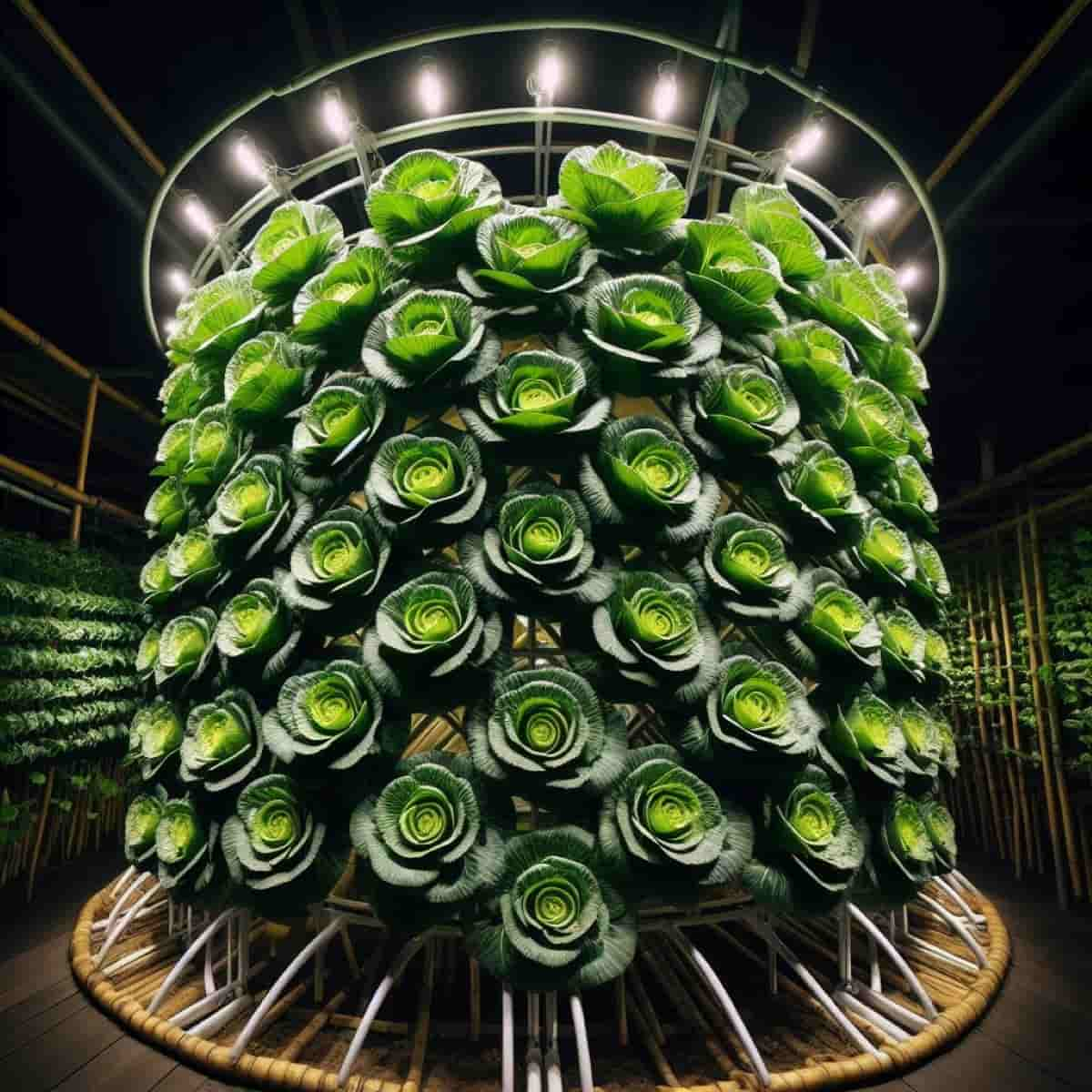Vertical farming has been gaining popularity in recent years, and for good reason. Not only does it offer a solution to land scarcity and urbanization challenges, but it also brings a host of benefits that traditional farming methods simply can’t match. Vertical farming is a groundbreaking technique that has taken agriculture to new heights, quite literally.

Instead of relying on traditional horizontal fields, vertical farming utilizes stacked layers or structures to grow crops in a controlled environment. This innovative approach offers numerous benefits for farmers and consumers alike.
Cabbage Farming in Vertical Systems
The Benefits of Cabbage Farming in Vertical Systems
Vertical Cabbage farming offers numerous benefits that make it an attractive option for growers. One of the key advantages is the efficient use of space. By growing Cabbage vertically, farmers can maximize their land usage and cultivate more plants in a smaller area. Another benefit is increased yield. Vertical systems allow for greater plant density, resulting in higher productivity per square meter.
This means that farmers can grow more Cabbages and generate higher profits from their operations. Vertical farming also provides better control over environmental conditions such as temperature, humidity, and light exposure. With precise monitoring and adjustment of these factors, farmers create optimal growing conditions for their Cabbage crops throughout the year.
Additionally, vertical systems offer improved pest management. Furthermore, vertical Cabbage farming reduces water consumption compared to traditional field cultivation methods. Through innovative irrigation techniques such as drip or hydroponic systems, water usage can be significantly minimized while still ensuring adequate hydration for healthy plant growth.
Comparison of Different Vertical Farming Methods for Cabbage Cultivation
When it comes to growing Cabbage in vertical farming systems, various methods can be employed. One popular method is hydroponics, which grows plants in nutrient-rich water solutions without soil. Another technique is aeroponics, which involves leaving plant roots in the air and misting them with a nutrient solution. Aeroponics provides optimal oxygenation to the roots while conserving water.
Vertical stacking systems utilize shelves or racks to grow multiple layers of crops vertically. This maximizes space efficiency and increases overall productivity per square foot. Alternatively, vertical towers or columns can be used to cultivate Cabbage plants individually or in clusters. Some farmers also opt for wall-mounted systems, where plants are grown on specially designed panels attached to walls or structures. These systems save floor space and provide an aesthetically pleasing display.
Choosing the Right Cabbage Variety for Vertical Farming
With the limited space in vertical systems, it’s essential to select varieties that are compact and have a shorter growing cycle. One popular choice for vertical Cabbage farming is the mini or baby Cabbage. These small-sized Cabbages take up less space but still offer all the nutritional benefits of their larger counterparts. They also mature faster, allowing for multiple harvests throughout the season.
Another option is choosing varieties specifically bred for container gardening or compact spaces. These varieties are often more disease-resistant and can thrive in confined growing conditions. When selecting your Cabbage variety, consider both its size requirements and flavor profile. Additionally, look for cabbage varieties that have strong stalks to support their vertical growth without any additional support structures. This will help prevent damage from wind or heavy rainfall.
Nutrient Management and Fertilization for Optimal Cabbage Growth in Vertical Systems
One key aspect of nutrient management is selecting the appropriate fertilizer for Cabbage cultivation in vertical systems. It is advisable to conduct soil tests beforehand to determine any deficiencies or excesses that need to be addressed. Organic fertilizers can be the best choice for vertical Cabbage farming, as they promote sustainable practices and reduce environmental impact.
In case you missed it: Cabbage Farming in Greenhouse: Growing Cabbage in a Controlled Environment

Options like compost, manure, or organic-based fertilizers help nourish the soil while minimizing chemical inputs. In addition to choosing the right fertilizer type, timing and application methods also play a vital role in nutrient management. Splitting fertilizer applications throughout the growing season allows for better absorption by the plants and reduces wastage.
Efficient Use of Space and Resources in Vertical Cabbage Farming
When it comes to vertical Cabbage farming, one of the key advantages is its efficient use of space. Traditional horizontal farming methods require large plots of land, which may not be available or economically feasible for everyone. However, with vertical systems, you can grow a substantial amount of Cabbage in a smaller footprint. Vertical farming allows farmers to stack multiple layers or shelves on top of each other, effectively maximizing the use of vertical space.
By utilizing this method, you can grow more Cabbages per square foot compared to traditional methods. This not only increases your overall productivity but also reduces the need for expansive farmland. Furthermore, vertical Cabbage farming also promotes efficient resource utilization. In these systems, water and nutrients are carefully managed and recycled within the system itself.
Through techniques such as hydroponics or aeroponics, water usage can be significantly reduced while still providing optimal growing conditions for the Cabbages. Additionally, controlled environments in vertical farms enable precise monitoring and management of resources like light and temperature. LED lights can be used to provide specific wavelengths that promote growth while reducing energy consumption compared to conventional lighting systems.
Automation and Technology in Vertical Cabbage Farming
Automation and technology have revolutionized various industries, including agriculture. With the use of advanced automation and technology, farmers can optimize their operations and ensure maximum yield from their vertical systems. One of the key technologies used in vertical Cabbage farming is automated irrigation systems.
These systems monitor soil moisture levels and deliver water directly to the roots of each plant, ensuring they receive precisely the right amount of hydration without any waste or overwatering. In addition to irrigation, automated nutrient dosing systems are also employed in vertical Cabbage farming. These systems provide plants with a carefully calibrated mix of essential nutrients at specific stages of growth, promoting healthy development and maximizing crop productivity.
Another crucial aspect of automation in vertical Cabbage farming is climate control. By utilizing sensors and smart devices, farmers can maintain optimal temperature, humidity, and light conditions for Cabbage plants throughout their growth cycle. This ensures that the crops thrive even in challenging weather conditions or limited space environments.
Pest and Disease Control in Vertical Cabbage Farming Systems
One effective method for controlling pests in vertical Cabbage farming is through integrated pest management techniques. For example, introducing beneficial insects can help control aphids or caterpillars naturally. Regular monitoring of the plants is also important to identify any signs of pest infestation early on. This allows farmers to take immediate action before the problem escalates.
In case you missed it: Top 10 Best Cabbage Varieties to Choose for Your Farm

Some common pests that affect Cabbage include aphids, caterpillars, flea beetles, and slugs. In addition to pests, diseases can also pose a threat to Cabbage crops in vertical farming systems. Fungal diseases such as black rot or clubroot can cause significant damage if left unmanaged. To prevent disease outbreaks, farmers should practice good sanitation by removing infected plant material promptly.
Harvesting and Post-Harvest Handling Techniques in Vertical Cabbage Farming
One of the most exciting aspects of vertical Cabbage farming is the harvesting process and post-harvest handling techniques. When harvesting, timing is crucial. Cabbages should be harvested when they have reached their desired size and firmness. This ensures that you get the best-tasting and highest-quality Cabbage. To harvest Cabbages in a vertical system, simply cut them off at the base using a sharp knife or shears.
The advantage of growing Cabbages vertically is that they are easily accessible, making the harvesting process much more efficient compared to traditional farming methods. Once harvested, it’s important to handle Cabbages with care to minimize damage and extend their shelf life. Remove any loose outer leaves and gently clean each head before storing or packaging them.
Sustainable Practices and Environmental Impact of Vertical Cabbage Farming
Vertical Cabbage farming offers several environmental benefits that make it an attractive option for those looking to reduce their ecological footprint. One of the key advantages of vertical Cabbage farming is its efficient use of space. By growing Cabbages vertically in stacked layers or hydroponic towers, farmers can maximize land utilization and minimize land degradation.
In addition, vertical Cabbage farming requires less water compared to conventional field cultivation. With precise irrigation systems such as drip irrigation or aeroponics, water usage can be optimized, minimizing waste and reducing pressure on freshwater sources. Furthermore, vertical farms are often located in urban areas or close to consumers, reducing transportation distances and carbon emissions associated with long-distance shipping.
In case you missed it: How to Protect Cabbage from Slugs and Snails: Natural and Organic Control

Vertical Cabbage farms also have the potential to mitigate soil erosion issues commonly seen in traditional farming practices. The controlled environment provided by vertical systems minimizes exposure to wind and rain erosion while preserving soil fertility for future crop cycles.
Conclusion
Vertical Cabbage farming allows for year-round production in any location, making it a viable option even in urban areas or regions with harsh weather conditions. Furthermore, the ability to control environmental factors such as light intensity and temperature creates optimal growing conditions for Cabbage plants. This not only improves crop quality but also increases yield potential, ensuring a steady supply of fresh Cabbages throughout the year.
The efficiency of vertical Cabbage farming is another key factor contributing to its bright future. With less water usage compared to traditional methods and reduced reliance on pesticides due to better pest management practices, this sustainable approach aligns with our increasing focus on environmentally friendly agriculture.
- Feed Your Flock for Less: Top 10 Tips to Save on Chicken Feed
- Ultimate Guide to Ossabaw Island Hog: Breeding, Raising, Diet, and Care
- Hatching Answers: The Top 10 Reasons Your Chickens Aren’t Laying Eggs
- Eggs and Economics: Breaking Down the Cost of Raising Backyard Chickens
- Defend Your Greens: Proven Methods to Keep Iguanas Out of Your Garden
- Ultimate Guide to Cinnamon Queen Chicken: A Comprehensive Guide for Beginners
- Ultimate Guide to California Tan Chicken: Breeding, Raising, Diet, Egg-Production and Care
- Ultimate Guide to Marsh Daisy Chicken: Breeding, Raising, Diet, and Care
- 10 Types of Chicken Farming Businesses You Can Start for Profits